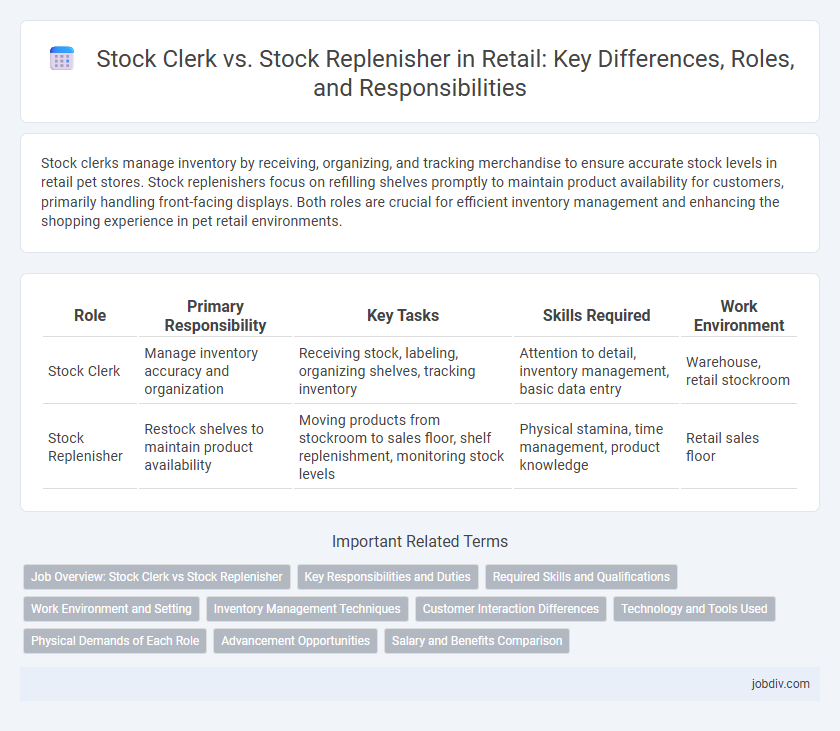Stock clerks manage inventory by receiving, organizing, and tracking merchandise to ensure accurate stock levels in retail pet stores. Stock replenishers focus on refilling shelves promptly to maintain product availability for customers, primarily handling front-facing displays. Both roles are crucial for efficient inventory management and enhancing the shopping experience in pet retail environments.
Table of Comparison
| Role | Primary Responsibility | Key Tasks | Skills Required | Work Environment |
|---|---|---|---|---|
| Stock Clerk | Manage inventory accuracy and organization | Receiving stock, labeling, organizing shelves, tracking inventory | Attention to detail, inventory management, basic data entry | Warehouse, retail stockroom |
| Stock Replenisher | Restock shelves to maintain product availability | Moving products from stockroom to sales floor, shelf replenishment, monitoring stock levels | Physical stamina, time management, product knowledge | Retail sales floor |
Job Overview: Stock Clerk vs Stock Replenisher
Stock Clerks are responsible for receiving, organizing, and maintaining inventory in retail stores, ensuring accurate stock levels and proper product placement. Stock Replenishers focus on refilling shelves by moving merchandise from storage areas to sales floors, prioritizing product availability for customers. Both roles are essential for inventory management, but Stock Clerks handle broader tasks including inventory checks and stock control, while Stock Replenishers concentrate specifically on shelf restocking.
Key Responsibilities and Duties
Stock Clerks manage inventory by receiving, organizing, and logging incoming products, ensuring accurate stock records and efficient storage. Stock Replenishers focus on maintaining shelf levels by restocking merchandise, arranging displays, and checking product expiration dates to optimize sales flow. Both roles support seamless inventory management but emphasize different stages of stock handling within retail operations.
Required Skills and Qualifications
Stock Clerks require strong organizational skills, inventory management knowledge, and attention to detail to accurately receive, store, and track merchandise. Stock Replenishers need physical stamina, time management abilities, and familiarity with retail shelf stocking protocols to efficiently maintain product availability. Both roles benefit from basic computer literacy, teamwork, and effective communication skills to support overall store operations.
Work Environment and Setting
Stock Clerks typically work in retail stores, managing inventory in dynamic, customer-facing environments where they receive, unpack, and organize merchandise on shelves. Stock Replenishers often operate during off-hours or quieter shifts, focusing on restocking products to maintain inventory levels in backrooms or sales floors, with less direct customer interaction. Both roles demand attention to detail and physical stamina but differ in their interaction intensity and timing within the retail setting.
Inventory Management Techniques
Stock Clerks primarily focus on organizing, labeling, and maintaining accurate inventory records to ensure efficient stock control, utilizing techniques such as barcode scanning and data entry systems. Stock Replenishers concentrate on restocking shelves based on sales data and inventory thresholds, employing real-time inventory monitoring and automatic reorder alerts to prevent stockouts. Both roles leverage inventory management software to optimize stock levels, improve order accuracy, and enhance overall supply chain efficiency in retail environments.
Customer Interaction Differences
Stock Clerks primarily organize inventory and manage stock levels with limited direct customer interaction, focusing on maintaining orderly shelves and accurate product displays. Stock Replenishers actively engage with customers by responding to inquiries and assisting with locating products while restocking shelves. The customer interaction of Stock Replenishers enhances the shopping experience by providing timely support, whereas Stock Clerks maintain backroom efficiency.
Technology and Tools Used
Stock clerks primarily utilize inventory management software and barcode scanning devices to track stock levels and organize merchandise accurately in retail environments. Stock replenishers often rely on automated replenishment systems, handheld scanners, and real-time data analytics tools to ensure shelves are consistently stocked based on sales patterns and demand forecasts. Both roles increasingly integrate mobile apps and RFID technology to enhance efficiency and inventory accuracy.
Physical Demands of Each Role
Stock clerks frequently engage in lifting heavy boxes, standing for extended periods, and navigating aisles to organize inventory, requiring considerable physical stamina and strength. Stock replenishers focus on restocking shelves with moderate lifting and repetitive motions, often involving bending and reaching to maintain product availability. Both roles demand endurance and physical agility, but stock clerks typically face more intense manual labor and mobility challenges.
Advancement Opportunities
Stock Clerks often have broader responsibilities including inventory management and customer assistance, providing diverse experience that can lead to supervisory roles. Stock Replenishers focus primarily on restocking shelves, which can serve as a foundational position for moving into inventory control or warehouse management. Advancement opportunities for both roles depend on skills like efficiency, attention to detail, and familiarity with inventory systems, with Stock Clerks generally having a slight edge due to varied duties.
Salary and Benefits Comparison
Stock clerks typically earn an average salary of $28,000 to $33,000 annually, while stock replenishers often make slightly less, ranging from $25,000 to $30,000, reflecting differences in job responsibilities and skill requirements. Benefits for stock clerks may include health insurance, paid time off, and employee discounts, whereas stock replenishers often receive similar benefits but with less variance depending on employer size and location. Employers in retail prioritize efficiency in inventory management, influencing compensation packages that balance hourly wages with performance incentives.
Stock Clerk vs Stock Replenisher Infographic

 jobdiv.com
jobdiv.com